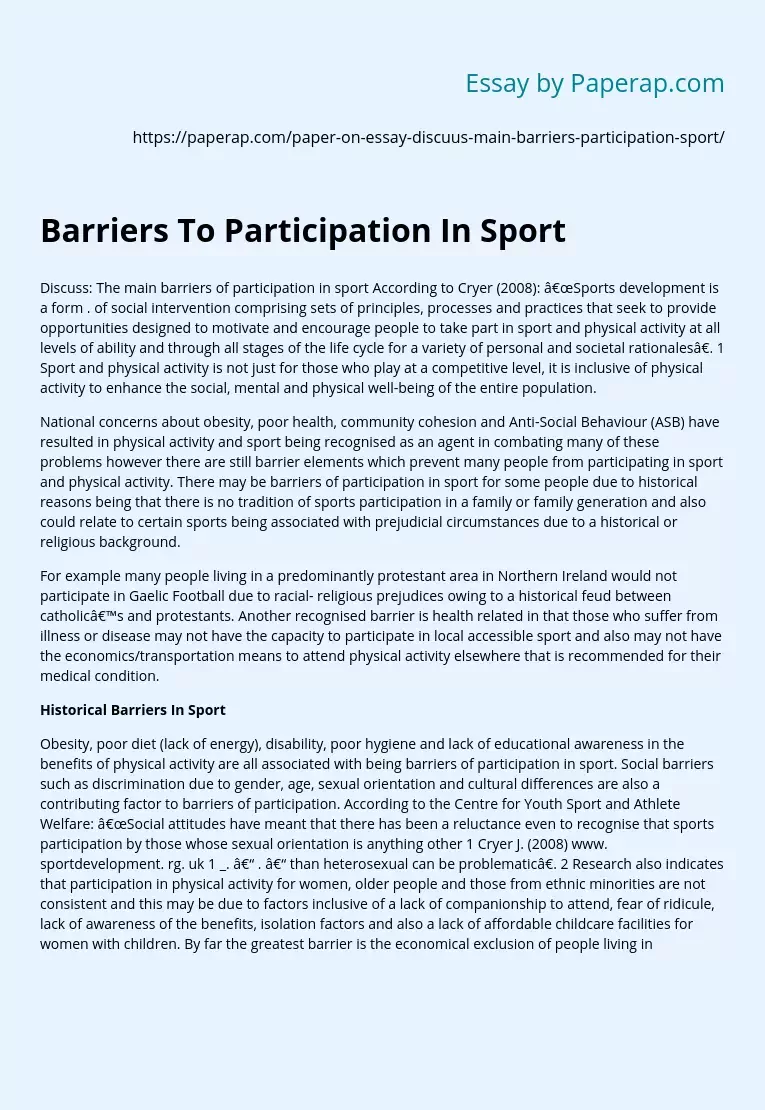Barriers To Participation In Sport
Discuss: The main barriers of participation in sport According to Cryer (2008): “Sports development is a form . of social intervention comprising sets of principles, processes and practices that seek to provide opportunities designed to motivate and encourage people to take part in sport and physical activity at all levels of ability and through all stages of the life cycle for a variety of personal and societal rationales”. 1 Sport and physical activity is not just for those who play at a competitive level, it is inclusive of physical activity to enhance the social, mental and physical well-being of the entire population.
National concerns about obesity, poor health, community cohesion and Anti-Social Behaviour (ASB) have resulted in physical activity and sport being recognised as an agent in combating many of these problems however there are still barrier elements which prevent many people from participating in sport and physical activity. There may be barriers of participation in sport for some people due to historical reasons being that there is no tradition of sports participation in a family or family generation and also could relate to certain sports being associated with prejudicial circumstances due to a historical or religious background.
For example many people living in a predominantly protestant area in Northern Ireland would not participate in Gaelic Football due to racial- religious prejudices owing to a historical feud between catholic’s and protestants. Another recognised barrier is health related in that those who suffer from illness or disease may not have the capacity to participate in local accessible sport and also may not have the economics/transportation means to attend physical activity elsewhere that is recommended for their medical condition.
Historical Barriers In Sport
Obesity, poor diet (lack of energy), disability, poor hygiene and lack of educational awareness in the benefits of physical activity are all associated with being barriers of participation in sport. Social barriers such as discrimination due to gender, age, sexual orientation and cultural differences are also a contributing factor to barriers of participation. According to the Centre for Youth Sport and Athlete Welfare: “Social attitudes have meant that there has been a reluctance even to recognise that sports participation by those whose sexual orientation is anything other 1 Cryer J. (2008) www. sportdevelopment. rg. uk 1 _. – . – than heterosexual can be problematic”. 2 Research also indicates that participation in physical activity for women, older people and those from ethnic minorities are not consistent and this may be due to factors inclusive of a lack of companionship to attend, fear of ridicule, lack of awareness of the benefits, isolation factors and also a lack of affordable childcare facilities for women with children. By far the greatest barrier is the economical exclusion of people living in poverty or with socioeconomic obstacles such as unemployment, living in large family households and one parent families.
In addition to this there is the dilemma of double disadvantage if these target groups are living in a deprived urban/rural area with poor infrastructure, lack of facilities and poor transport services. This results in the further exclusion of many people and in some cases the exclusion of entire communities to participate in sport and physical activities. Sadly this is a major contributing factor to why a community becomes dysfunctional and in order to understand a community we must acknowledge the basic human needs to form and keep social connections, to develop a sense of belonging, and to furth. er increase a self-identity.
The government and local authorities need to recognise the arena of inputs from local community voluntary sports/youth clubs and identify that these organisations necessitate sustainable funding to support local communities, assist to overcome barriers of participation and offer outlets for people to be socially and physically involved in sport and fitness activities. They are in a unique position to offer the basic ingredients of self-worth: knowledge, cultural diversity and awareness and can be organised to deliver programmes that engage with abilities and disabilities introducing positive identity structures.
With so many barriers to overcome being historical, health related social and economical, for the effective participation of all in society, the government and local authorities need to have coherent planning and thinking in community sports development and its contributions to promoting sport and physical activity that enhances positive mental, physical and social wellbeing.
2 Brackenridge C. , Alldred P. , Jarvis A. , Rivers I. , (2008) ‘A Review of Sexual Orientation in Sport’ – sportscotland Research Report no. 14. for. sportscotland, Sport Northem Ireland, Sport England, UK Sport (Centre for Youth Sport and Athlete Welfare, Brunei) page 7 2 :’ _ … _. ••• – . _1″””” Bibliography: Cryer J. , (2008) www. sportdevelopment. org. uk Brackenridge C. , Alldred P. , Jarvis A. , Rivers I. , (2008) ‘A Review of Sexual Orientation in Sport’ – sportscotland Research Report no. 114. Research study for: sportscotland, Sport Northern Ireland, Sport England, UK Sport (Centre for Youth Sport and Athlete Welfare, Brunei) page 7 . 3 – – . -.
Barriers To Participation In Sport. (2019, Dec 05). Retrieved from https://paperap.com/paper-on-essay-discuus-main-barriers-participation-sport/

